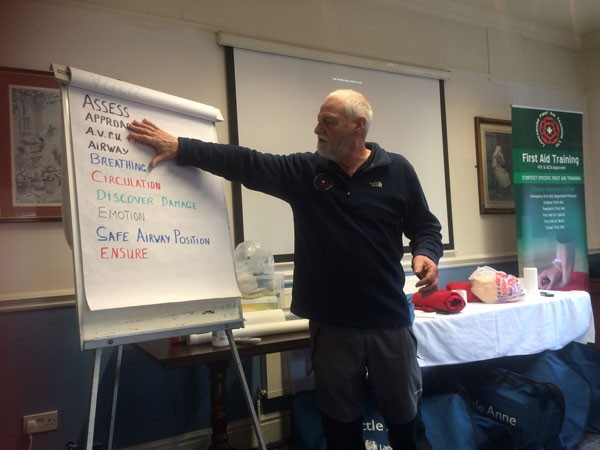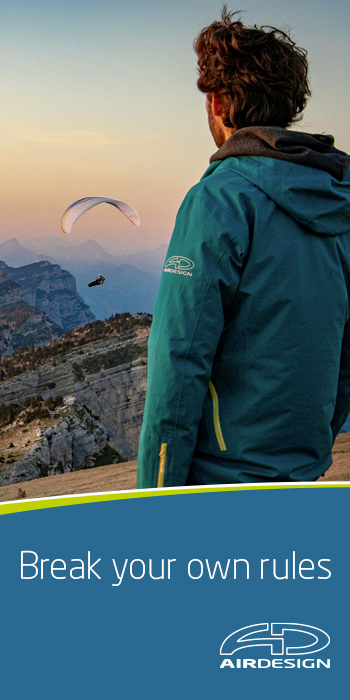
So you think you know your First Aid?

Keith Gillies from Lancashire First Aid Training unit

Pennine Club members play injured

Would you know what to do if there was an accident on your local flying hill, or one of your party became injured in the mountains? And how about CPR – is it 3 breaths and how many chest pumps again…?!
I spent a day with the Pennine Soaring Club in the UK and a profesionnal team from the Lancashire First Aid Training unit, learning all about it. With assistance from 20 other club members and some “Annie” CPR dummies, I left feeling confident that in any given situation I would know what to do. So whilst you’re searching closer to home of where to get on your next First Aid course, here are some pointers:
With any accident it is really important that someone takes control and manages the situation. A lot of people will want to get involved and, even though it is well intended, this is not always in the casualty’s best interest. Don’t be afraid to take charge and quietly but firmly ask people to do things to help you.
ASSESS
Is it safe for you or anyone else to approach the casualty? Don’t risk further casualties. If power lines are involved do not approach the casualty until you know the power has been switched off. Keep onlookers away – people are naturally curious.
Find out if there are any First Aiders or medical people present and hand over to them – they will know what to do. Try to prevent every one on the hill telephoning 999 all at once – this will help the Emergency Services.
APPROACH & STABILISE
When it is safe to approach, get the glider stabilised so that the casualty does not get dragged and injured further. If you can unclip the pilot from the glider without risk of moving their head, back or limbs then do so.
Tell the casualty your name and that you are there to help. Ask for their name – this will help establish if they are responsive. If they are responsive they will be able to tell you what they feel like, what hurts etc.
Stop them from trying to move about, make them as comfortable and possible and re-assure them until any injuries have been established and help called if necessary.
If they are unresponsive, or even just groggy, it is essential to get medical help. Get one person to call emergency services.The information needed will be exact location (a Grid reference/GPS coordinates are ideal), nature of accident, type of terrain, where the ambulance will be met. Send a volunteer to this location straightaway.
If a mobile is available the emergency services can give advice to First Aiders over the phone.
ABC – Airway, Breathing & Circulation
If a casualty is not breathing they will die irrespective of any other injuries they may have. Only move the casualty if you need to get them breathing. Listen and feel for breathing. If there are no signs you will first need to check they have a clear airway. Check they haven’t swallowed their tongue – if they have pull it out. Keep talking to them even if they seem unresponsive – re-assurance is what they need. You can delegate this task especially if they have a mate on hand whose voice they’ll recognise.
If there is no breathing give artificial respiration mouth to mouth or mouth to nose.
If there is no pulse then administer artificial respiration and chest compressions.
If they are bleeding badly, raise the affected limb and apply firm pressure to the wound to try to control this.
If the casualty can be moved then put something warm between them and the ground. Clothing can also be used to support damaged limbs until help arrives.
Do not give any drinks, food or medication. You can moisten their lips with water.
When help arrives tell medical staff what you have seen and any changes in the casualty’s condition. This may help their assessment.
Find out from your local flying club about any future First Aid events or locally when the next Red Cross/First Aid training sessions are likely to be.
Courses usually only take a day, and they can save lives.
With special thanks to the Pennine Soaring Club, UK
I spent a day with the Pennine Soaring Club in the UK and a profesionnal team from the Lancashire First Aid Training unit, learning all about it. With assistance from 20 other club members and some “Annie” CPR dummies, I left feeling confident that in any given situation I would know what to do. So whilst you’re searching closer to home of where to get on your next First Aid course, here are some pointers:
With any accident it is really important that someone takes control and manages the situation. A lot of people will want to get involved and, even though it is well intended, this is not always in the casualty’s best interest. Don’t be afraid to take charge and quietly but firmly ask people to do things to help you.
ASSESS
Is it safe for you or anyone else to approach the casualty? Don’t risk further casualties. If power lines are involved do not approach the casualty until you know the power has been switched off. Keep onlookers away – people are naturally curious.
Find out if there are any First Aiders or medical people present and hand over to them – they will know what to do. Try to prevent every one on the hill telephoning 999 all at once – this will help the Emergency Services.
APPROACH & STABILISE
When it is safe to approach, get the glider stabilised so that the casualty does not get dragged and injured further. If you can unclip the pilot from the glider without risk of moving their head, back or limbs then do so.
Tell the casualty your name and that you are there to help. Ask for their name – this will help establish if they are responsive. If they are responsive they will be able to tell you what they feel like, what hurts etc.
Stop them from trying to move about, make them as comfortable and possible and re-assure them until any injuries have been established and help called if necessary.
If they are unresponsive, or even just groggy, it is essential to get medical help. Get one person to call emergency services.The information needed will be exact location (a Grid reference/GPS coordinates are ideal), nature of accident, type of terrain, where the ambulance will be met. Send a volunteer to this location straightaway.
If a mobile is available the emergency services can give advice to First Aiders over the phone.
ABC – Airway, Breathing & Circulation
If a casualty is not breathing they will die irrespective of any other injuries they may have. Only move the casualty if you need to get them breathing. Listen and feel for breathing. If there are no signs you will first need to check they have a clear airway. Check they haven’t swallowed their tongue – if they have pull it out. Keep talking to them even if they seem unresponsive – re-assurance is what they need. You can delegate this task especially if they have a mate on hand whose voice they’ll recognise.
If there is no breathing give artificial respiration mouth to mouth or mouth to nose.
If there is no pulse then administer artificial respiration and chest compressions.
If they are bleeding badly, raise the affected limb and apply firm pressure to the wound to try to control this.
If the casualty can be moved then put something warm between them and the ground. Clothing can also be used to support damaged limbs until help arrives.
Do not give any drinks, food or medication. You can moisten their lips with water.
When help arrives tell medical staff what you have seen and any changes in the casualty’s condition. This may help their assessment.
Find out from your local flying club about any future First Aid events or locally when the next Red Cross/First Aid training sessions are likely to be.
Courses usually only take a day, and they can save lives.
With special thanks to the Pennine Soaring Club, UK

DISCOVER
– Pennine Soaring Club, UK has some of the UK’ finest XC launch spots

Stay in touch with the most popular publications by receiving for our NEWSLETTER Fast and easy – takes 1 minute!


